Ferrari’s “place holder” front engined V12
by Wallace Wyss –
By the time Ferrari was still selling the 275 GTB, the concept of a front engine GT car being top dog was getting a little old.
Why? Because that damned Ferrucio Lamborghini had introduced the Lamborghini Miura which was mid-engined.
Doubly embarrassing for Ferrari because he had been fielding mid-engined racing cars for years, just never figured the public would want a car so bereft of luggage room and with the attendant cooling problems.
Now Enzo Ferrari had a mid-engined car in the works as a production car–the 365 GT4BB (Boxer Berlinetta).
But it was still a long way off. Meanwhile the 275 GTB was getting old, so the problem was filling the void as until the Boxer would be ready. Solution? To have Pininfarina designed a new looking car that was based on the 275 GTB.
Ironically the plans didn’t quite gel as he envisioned. The Boxer took so long to get sorted out, by the time it was ready, the rules had changed in the US and it would have taken even longer to qualify it for US importation so he passed on that market but meanwhile the Daytona was doing well in the U.S. The “placeholder” was a winner.
So he used much of the 275 GTB/4 and one could argue that the Ferrari Daytona, if you squint at the side views of it compared to the 275 GTB, was really just a sharpening up of the lines of that car with the adding of rear 3/4 windows.
The Daytona would have a larger engine than the 275, a 4.4-liter V12 engine, and all of them would come with six Weber twin-choke 40 mm carburetors (some of the 275 GTB’s had three carburetors), and the Daytona would have good weight distribution provided by the rear mounted transaxle gearbox .
It had a long, long nose with two very subtle flush deck hot air relief vents. The originals had the headlights fixed in place and showing through plexiglass but those wouldn’t meet US standards so for the US ugly popups were used with US legal headlamps.
As per Ferrari practice, the new model was rolled out first at the Paris Salon, this one in the autumn of 1968. Though it did not say “Daytona” in script anywhere on the car, its nickname became “Daytona”, supposedly in recognition of the Ferrari 1-2-3 sweep in the Daytona 24-Hour Race in 1967.
Many Ferrari fans look back on the Ferrari Daytona with no small amount of nostalgia because it was the last new 12-cylinder Ferrari model announced before Fiat swept in to take over road car production in 1969, with a purchase of 40 per cent of the stock with the provision that the remaining 49 per cent would come to them upon the death of Enzo Ferrari.
It was also the last 12-cylinder Ferrari to be sold new in the USA (through official channels) until 1984. People forget the Boxer was a 12 cylinder, but a flat 12 and not sold officially in the U.S., only as a gray market model. The Testarossa, finally brought a new 12 cylinder Ferrari to the U.S.
Early prototype Ferrari Daytonas had sort of a strong 275 GTB/4 influence but that could have been to disguise the mules. Ferrari worried so much that Americans would feel “cheated” that they didn’t get the full width Plexiglass strip between the headlights on the European model that they added a silver band across the front, sort of simulating the strip but finally just made that portion body color.
Like the Dino and other Pininfarina-designed Ferraris, it had a chopped “Kamm” effect tail, and twin round tail lamps.
The body, though designed by Pininfarina, was still built the old fashioned way by Scaglietti, most of them in steel with aluminum doors, bonnet, and boot lid, although later in the production run the doors were changed to steel, and bracing struts added to suit US laws.
The cabin was a five-window design with a large lightly curved windscreen and an almost flat rear screen bounded by sail panels (with inset rear ¾ windows) that ran in a continuous line into the tail panel.
A SPYDER
As is usual with Ferrari, the open car came later, in this case almost a year later, as the 365 GTS4, premiered at the 1969 Frankfurt Show. It kept most of the body style from the waist down. There was also a one off targa made with a roof rollover bar similar to the Porsche targa and a retractable plastic rear window.
The spider was so popular it took 10 per cent of Daytona model sales. In fact Ferrari couldn’t meet demand and shops like that of Richard Straman in Costa Mesa, CA cut dozens of coupes into spiders. The usual number of spiders made by the factory is roughly 122-125.
The usual overall number for production is 1,284 Ferrari Daytona Berlinettas and 122 Ferrari Daytona Spiders produced. That overall number is fairly close to what I call the “magic number” of 1,000. As long as a given model car has around 1,000 produced, it has some collectability, hence for example the Lamborghini Muira is under that, the Gullwing Mercedes is at 1,400 cars, the Detomaso Mangusta at 402 cars, etc.
THE ENGINE
The engine was derived from the 275 GTB/4 engine, but larger, factory type reference 251, with 4390cc capacity, with a bore and stroke of 81mm x 71mm. Every one of them dry sump lubrication. It was fitted with a bank of six twin-choke Weber 40 DCN20 or 21 carburetors, those of the USA market cars carrying the suffix “A”, with a twin coil and rear-of-engine mounted distributors and ignition system, with an electronic system fitted to USA market versions, to produce a claimed 352 hp.
Because the US market had so many exhaust requirements, the Daytona was burdened with a fast idle device and an exhaust manifold air injection system.
It still had a great sound, however.
The engine drove through a flywheel-mounted clutch, via a shaft running at engine speed in a torque tube, mated to a five-speed transaxle mounted almost identically to that of the 275 GTB4. The suspension was wishbones, coil springs and hydraulic shock absorbers at each wheel.
Even the regular Daytona could do 174 mph but there were a few racing cars made, again reluctantly, after his dealers started to make their own. From the factory there were three series , each consisting of five client competition cars built at the factory’s “Assistenza Clienti” department in Modena. Earlier a one-off all-aluminum bodied car had been built for Luigi Chinetti’s North American Racing Team.
The first series of five full comp cars, built in 1971, had all aluminum bodies. They featured slightly flared wheel arches with wider wheels, aerodynamic “fences” on the front wings, a small chin spoiler, and no quarter bumpers.
The second series, produced in early 1972, had steel bodies with the aluminum bonnet, boot lid, and doors of the road cars, but with much increased flares to the wheel arches, to accommodate even wider wheels and tires. A third series showed continued cost cutting, those made in early 1973, but with steel doors, and only the bonnet and boot lid in aluminum.
The Comp cars were successful in GT. At the Le Mans 24-Hour Race in 1972 they finished in the top five positions in their class, repeating the class wins there in 1973 and 1974. As late as 1979, they were still performing well, even taking a second overall in the Daytona 24-Hour Race, amazing when you consider the car was now an old used model that had been out of production for six years.
MY DRIVE IN A FERRARI DAYTONA
I only drove a Daytona a couple of times. The first was when a young heir went out and dumped his inheritance on a Daytona for about $19,000 in the early ‘70s and preceded to drive it like a hellion for months until he was talked out of it by a slick talking car dealer who traded him five cars of dubious value for it.
I was impressed by the speed, and the roar of the engine but didn’t care for the fact you had to wait for the car to get warm or else you’d damage the gears in the rear mounted gearbox. And the steering was very stiff, and there was no power steering. So it was a brute of a car to drive around town.
The second time I drove one was when I was thinking of buying one for $43,000, but the gears had already been damaged by that problem of the gearbox needing to be warmed up before you did a lot of shifting. Who knows what a gearbox rebuild would’ve been back then, in the early ‘60s? Last time I looked even the average Daytona was selling for ten times that long-ago price so I woulda, coulda/ shoulda….
THE FUTURE
The Daytonas have a certain amount of classic styling grace that has kept them looking modern all these years. I have to say that, looking back from 2016, the only flaw I can find as a design critic, is that the taillights now seem too small by about 25%. Daytonas are continuing to climb in value, with those with documented racing history now leading the value parade, with spiders next, and those with celebrity rub-off (starring in films) having their fans as well.
Let us know what you think in the Comments.
THE AUTHOR/ARTIST: Wearing his artist hat, Wallace Wyss says, if there’s demand he will be offering some prints of his Daytona art on his website wallacewyssfineart.com


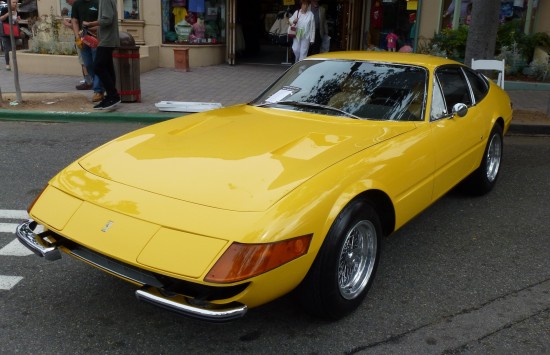
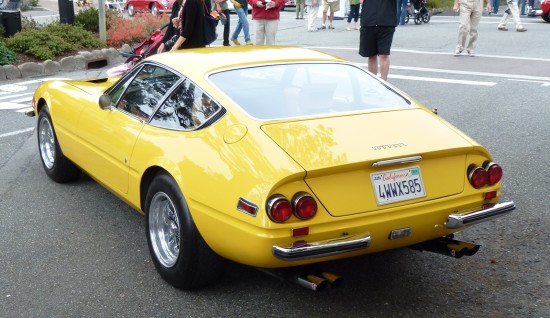
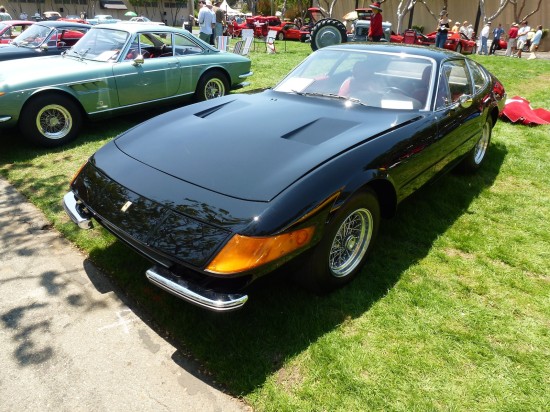
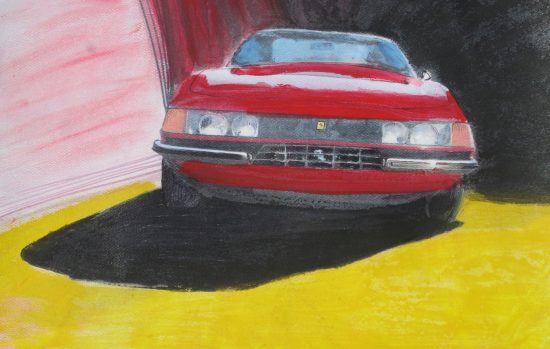
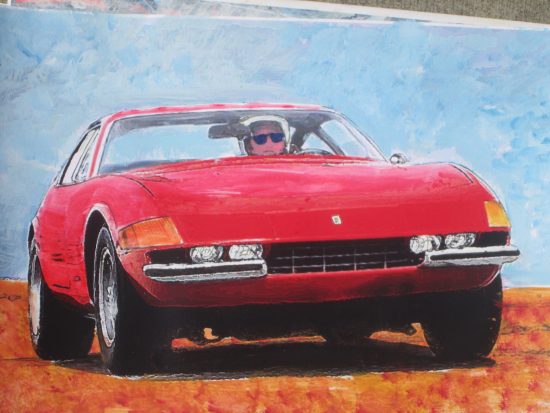
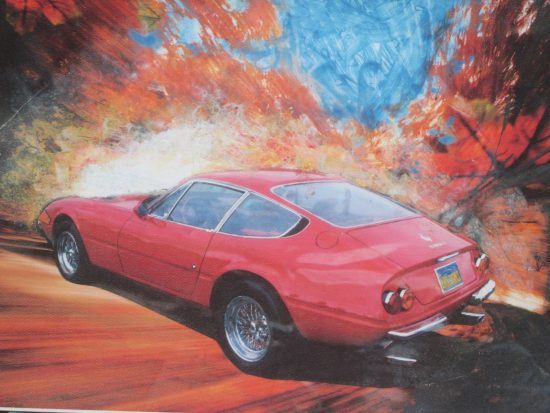
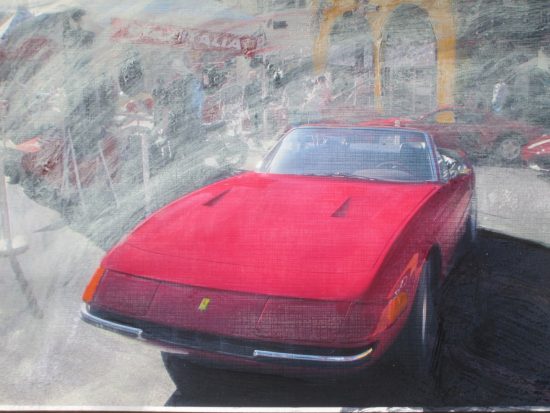
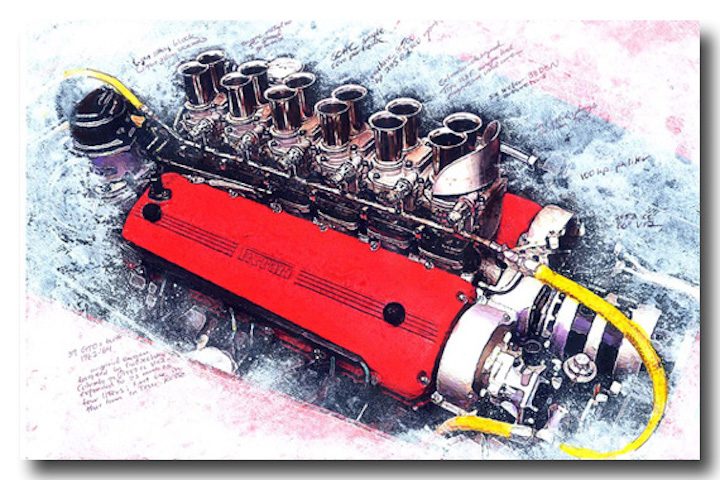

I think someone put it on the scales and it weighed 3,888 pounds. It would go but also eat tires like crazy. I just like a front engine car.
One of the most beautiful Ferraris ever made.
. . . and best in black.
great article, great pictures
A terrific design that just gets better with age.
Very graceful.
As for flaws, …… its what we love about them.
I bought my Daytona #13983 in February 1975 for £2800 GBP
Kept it one year then sold to Australia for a small profit
My book ‘Let them stare’ details the car which I loved very much !